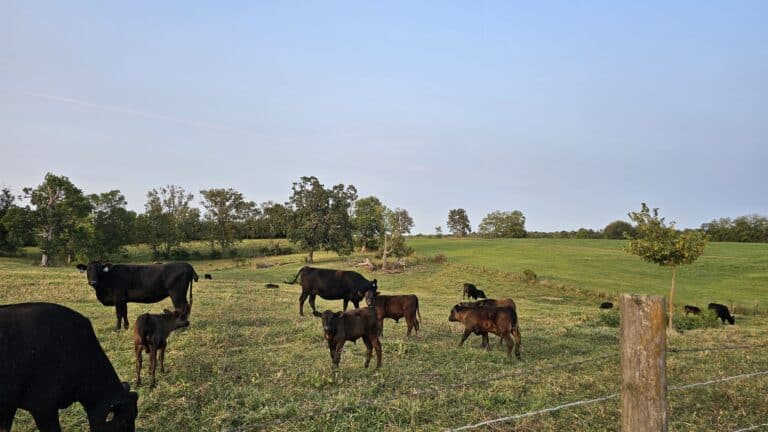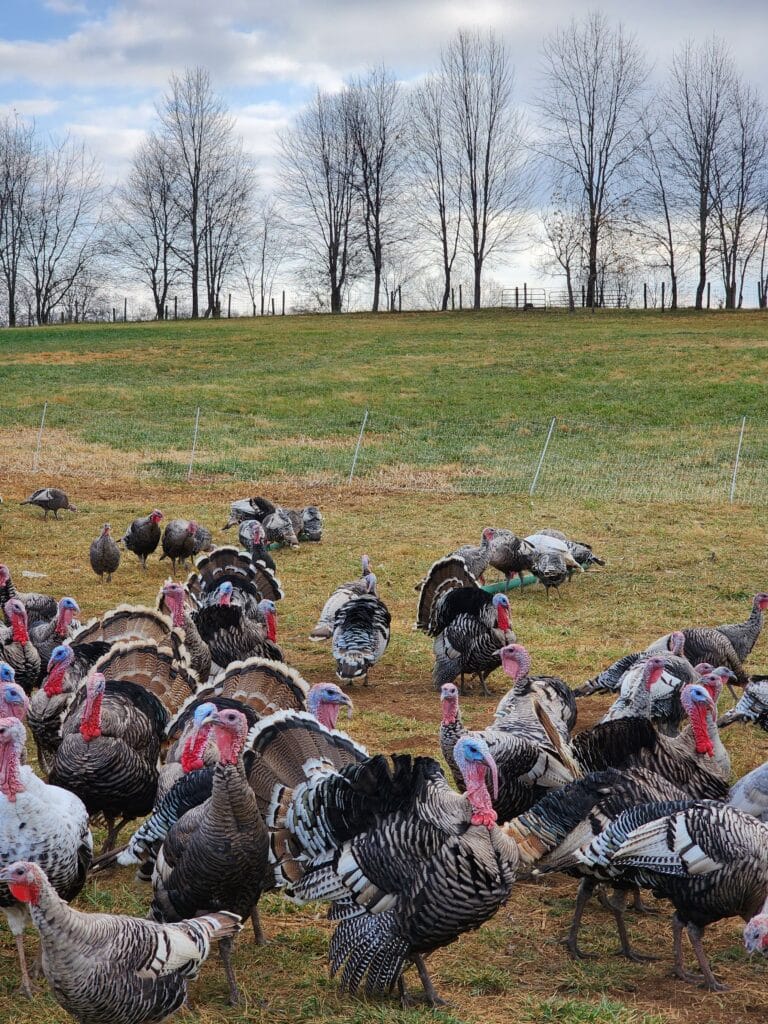
Each week we work hard to bring a bounty of vegetables from our fields to both the farmers market and in your CSA boxes. What you might not realize though is that our livestock play an extremely important role in making that possible. Not only do they convert solar energy into wholesome meat, they are a valuable tool in our vegetable-production arsenal. From nutrient cycling to weed eating, their services actually save us labor.
Our cattle, of course, are a prime example. We have sections of hilly landscape here on the farm which appear at first glance to be unused but they are far from idle. They’re maintained as permanent pasture, never to see a plow since the erosion potential is too high. The roots of the plants growing there hold the soil in place. The plants also convert solar energy into complex carbohydrates, proteins, vitamins and minerals through photosynthesis. Typically some combination of grasses like fescue-bluegrass-orchardgrass and legumes like red or white clover are grown in these fields. And of course there are the waves of weeds that proliferate each season.
But the cattle who graze there don’t just bite off whatever they find in a field. They carefully select which plants or plant parts to ruminate on and do a marvelous job of stripping weed seeds from the tops of those plants as the seeds ripen. Other times we’ve seen them eating thistle flowers when they are just turning purple. In this way, they are converting the energy the plants captured from the sun and are producing high quality beef for us to consume, all while the plants are holding and building soil. The soils of the Inner Bluegrass have a balance of nutrients particularly beneficial to livestock that consume the forages grown on them.
These are animals, some well over a thousand pounds, that eat a lot. To best feed them, they are first divided into groups based on their stage of life and then we move each group from pasture to pasture as they graze the forage. We do this with temporary electric fence systems that are a quick way to divide up a field. The decision on where the fence goes is dependent on how big the paddock needs to be for 2-3 days of grazing, which is dependent on how lush the grass is.
The herds understand how this rotation thing works. They are keenly aware when the field they are in is eaten down or picked over. When they hear us coming, they begin moving towards their next paddock. We have the next couple of paddocks laid out ahead of time, so when it is time to move, it is as simple as spooling up the wire and allowing the group to flow into the fresh field. We gauge how aggressively they eat to see if we made them wait too long, or not long enough. This is a balancing act, as we want them to stay to eat more weeds, but we do not want to compromise their nutrition.

This pattern and practice extends beyond just our cattle. Our pigs, sheep, chickens and turkeys are also rotated along with portable electric fencing and moveable outdoor shelters every few days to let picked through pastures rest and revitalize while they get to enjoy fresh grass. Then the cycle continues. This time of year we especially love getting to watch our flock of turkeys stretch their legs, peck and scratch and enjoy displaying their turkey tendencies out on pasture each day. Happier, healthier turkeys in turn means more delicious and nutritious meat which is a welcome blessing any time of the year, but especially as turkey pre-orders are now open in preparation for the holiday season.
So now you’re probably wondering, how does all this impact our vegetables? Well come winter when pastures are mostly dormant, we switch to feeding hay grown here on our farm and move our livestock to where they are most beneficial—next year’s vegetable fields. The herd gleans the produce from the crop fields in the fall and eats or destroys any weeds while the fields gain the nutrients where they need them the most to ensure a plentiful growing season and harvest to come.
Raising animals regeneratively is in some ways a labor of love but we know that they pay us back in dividends, both in the way they benefit the land and benefit us with better-for-you meat.
Mac Stone



Made with 
